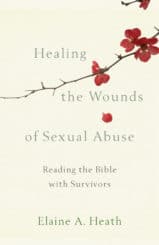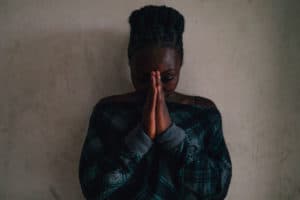
It was the middle of summer, and I was preaching through a series entitled “Men, Women, and God.” While the congregation was accepting of me as their pastor, they still tended to have patriarchal views about gender. Our church was in the Ohio River Valley, a region with unusually high rates of sexual abuse and domestic violence.(1) My goal in the sermon series was to introduce the congregation to deeper levels of the healing and liberating power of the gospel. As part of the larger goal, I wanted them to experience a reading of several biblical texts that could help to prevent and heal the sexual abuse and domestic violence in our city.
On this Sunday, several weeks into the series and after I had established a biblical foundation for gender equality, I preached about the sin of childhood sexual abuse. I talked about its presence even among Christians, its relationship to patriarchy, and how the church could help to prevent and heal this form of violence. My biblical text was the story of the woman at the well in John 4. The congregation was unusually quiet, listening intently as I preached about the woman’s worth in God’s eyes and how her series of rejections as an adult could very well have been the outcome of the wounds of sexual abuse. Certain aspects of her adult life, I said, are consistent with what we see in survivors of childhood sexual abuse. Instead of looking at her story as just one more example of an immoral woman, what if we thought about the kinds of childhood experiences that can move a person toward this much chaos as an adult? This familiar story from the Gospels was a way to ease into a very difficult subject as we considered some of the consequences of childhood sexual abuse for adult survivors. As I spoke of the struggle survivors sometimes have with perfectionism and anxiety, and other consequences of sexual abuse, I noticed several people had tears in their eyes.
Bringing the message to a close, I briefly mentioned the systemic layers of oppression that faced this woman and further isolated her from her own people and religious community. In short, I was linking the sin of childhood sexual abuse to the larger systemic issue of patriarchy. The good news, I said, is that this unnamed woman became the first evangelist. Jesus saw beyond the surface of her dysfunctional relationships to the misery of her life. More than that, he saw the person she could become. Jesus trusted her, wanted to drink from her cup, was willing to be seen talking to her. Jesus did not shame her. When Jesus met her, he saw someone who wanted to be a true worshiper. This woman was not doomed to live in the shadow of her abuse forever. Because of Jesus, she found her own voice and with it led others to the one who set her free.
I saw Jesus with me and in me, suffering everything. I saw his love for me, his unwillingness for me to suffer alone, and his judgment against the abuse.
After the benediction, I followed custom and greeted people as they were leaving the church. An older woman, Laura, lingered at the edge of the sanctuary. Her husband, Marty, had already gone out to the car. They were usually there on Sundays but kept to themselves and rarely came to fellowship events. I always thought their reticence was because they were new in town, having moved there just a year before I did. When we passed the peace, Laura stood still instead of moving into the aisle. She stared ahead and only greeted others if they first spoke to her. Marty was a little more outgoing, but not much. They were both tall and dignified. Nearly 80, Laura was still strikingly beautiful, with her shoulder-length white hair and stylish clothing.
When the last person had left the sanctuary, Laura approached. Taking my hand, she looked into my eyes and was silent, searching for the right words. Finally she spoke. “Pastor, what you preached about really touched me. For the first time in my life—and I have been going to church my entire life—I actually understood every word of the sermon.”
“Thank you, Laura!” I said, surprised by her comments, because she had been listening to my sermons for nearly two years. Why would she understand this sermon and not the others? There was something more that she seemed to want to say, so I waited.
With no change in facial expression or tone of voice, Laura matter-of-factly continued, “My neighbor and his friend raped me. Two of them, together, one after the other. They were in high school. I was 7 years old.” The words came out with no more emotion than if she were telling me what she had for dinner the night before. “I hadn’t thought of it in a long time. Your sermon made me remember it.” The faintest glimmer of pain began to show in her eyes. “I’ve never told anyone before,” she whispered. That sermon marked the beginning of Laura’s healing.
Today Laura experiences the love of God, laughs freely, and participates in Bible studies and outings with friends. She and Marty have become favorites of many of the younger adults at the church, who are often dinner guests at the couple’s home. Although she is still reserved by nature, Laura has definitely found her voice, and she is a blessing to everyone around her. She is compassionate, a deep thinker, a joy to her friends.
Why Survivors Disconnect from the Church
As Laura explained in one of our many conversations after the disclosure of her abuse, prior to the advent of her healing, she had never been able to experience prayer or spiritual feelings the way other people seemed to. Although she is bright, she did not understand the Bible very well or desire to read it. When pastors stood up to preach, she disconnected. There was an internal block that she could not comprehend. Deep within her heart she longed to know God more fully, and she wanted to experience the love of God that others described. But doing so was not possible until she heard her own story of suffering within the biblical text and experienced a pastor who could validate her story and speak of it in terms of healing and redemption. She had to experience the gospel interpreted by a survivor.
Laura is only one of many survivors of abuse I have been privileged to know over the years in my roles as pastor, spiritual companion, retreat leader, professor, and friend. Her story is unique, yet in some ways Laura exemplifies people everywhere who have survived childhood sexual abuse. Often they are internally if not outwardly disconnected from Christianity, the church, the Bible, and clergy. Much of their alienation has to do with how the Bible is read and interpreted in the church. Some of it has to do with excessively gendered language for God in hymnody, prayers, and the liturgy. The church’s obsession with sexual sin coupled with its poorly developed theology of sexuality only compound the alienation. (Many survivors, for example, think of the church’s polarization around sexual orientation as being focused on the wrong set of questions. They believe that an orientation toward sexual violence, rather than toward a particular gender, is the orientation that is inherently sinful.)
Laura had been in the church for a lifetime, carrying the painful secret of her abuse, not knowing how it shaped the rest of her life, how it filled her with shame, how it erected barriers between herself and the love of God, how it prevented her from feeling safe and loved even with trustworthy people. No one ever spoke from the pulpit or anywhere else in the church about sexual abuse and its consequences. Laura experienced decades of patriarchal biblical interpretation that reinforced the message that men and their desires and needs are what matter the most. She had internalized the belief that the Bible teaches that women and girls exist to serve men, no matter how painful and dehumanizing that might be. All the God images that had been given to her were male. Inwardly, without knowing exactly why, she shut down whenever a man stepped into the pulpit and spoke of a male God, especially one who is all powerful. The Bible held no attraction to her, for it was the voice of a male God protecting male interests. Even though Laura was a moral person, she spent a lifetime feeling defective—feeling like an outsider in church and community because of her hidden shame.
Once Laura heard the good news of the gospel for survivors, once she realized how relevant the Bible was to her own story, her heart opened wide to the healing love of God. What then happened to her and what has happened to me and so many others I have known is nothing short of miraculous. Laura has come home to God and to herself. Laura’s healing has taken time and has included many resources such as therapy, the cultivation of healthy friendships, and pastoral care. But the turning point for her was when the Bible was interpreted so that she could locate her specific suffering in its story of redemption. Laura was evangelized when the Bible was read through the eyes of a survivor.(2) Her evangelization was holistic, a process of initiation into a life of wholeness and wholehearted discipleship.
How many women and men are walking among us today bearing the wounds of sexual abuse, alienated from the God who longs to heal them, not knowing the power of the gospel because pastors and church members have not learned to read the Bible with survivors of sexual abuse? Imagine what it would mean if seminary curriculum required students to learn about sexual abuse and presented them with a hermeneutic of Scripture that was healing and liberating. Think of the impact the church could have in preventing and healing sexual violence. Think of the missional potential in introducing hurting people to the love of God. Could it be that one of the reasons the church is failing to evangelize people today is that we are not taking seriously the pervasive reality of sexual abuse and its consequences for survivors—that we are not offering them the good news they need to hear?
Waking Up
My vocation in ministry and as a theologian has emerged from my own journey into shalom. Like Laura, I am a survivor of sexual abuse. The awakening for my healing took place when one of my daughters was in the fifth grade. She brought a note home from school asking for parents’ permission to allow students to see a film warning about the dangers of sexual predators. Parents were invited to come to school and preview the film before giving permission for their children to see it. I went to the school on the appointed night and watched the film along with other parents. The main vignette was about a little girl whose next-door neighbor, an older man, groomed her for sexual abuse. Because her parents were not paying attention and the child was vulnerable, she was victimized by the man next door. The film was vague enough to be appropriate for fifth graders but deeply disturbing to the other parents and myself.
As I walked home with a neighbor, she asked what I thought about the film and whether I would allow my daughter to see it. All of a sudden the words rushed out, surprising me with their stark truth. It was as if I were listening to someone else say, “I was that child. That is what happened to me.” The woman looked at me, horrified, and didn’t know what to say. I myself didn’t know what to say. I could not believe I had told this neighbor, whom I scarcely knew, the darkest secret of my life. As soon as the words were uttered, a wave of shame engulfed me. I was glad for the darkness of the night so that she could not see my embarrassment. It would take years to come to terms with that shame and to be delivered from the feeling of uncleanness that had been put in me by my perpetrators.
Until then I had never given a name to what I had experienced as a child. One of the offenders was a pastor. His abuse damaged my view of Christianity and God in ways that would take decades to heal. The words abuse, molested, and raped were not words I used to describe my own experience to myself as the years went by. In fact, I did not articulate my own story of abuse to myself or other people. I remembered it at times but quickly moved those memories to the back of my mind and busied myself with the work at hand. Like many survivors, I was active in my church and a devoted mother to my children. I tried to be a “good person.” I did not know how deeply anxiety and shame controlled my daily life, because my eyes had not yet been opened to how the abuse had affected me. That night as I walked home from my children’s school, I woke up. It was the beginning of my healing journey. It was the first time I honestly named what had happened to me when I was a child.
I did not know how deeply anxiety and shame controlled my daily life, because my eyes had not yet been opened to how the abuse had affected me.
The major turning point in my spiritual healing came several years later. By this time I had been a Christian for 20 years and had experienced a measure of healing from the residual effects of the abuse. I had just begun seminary. One day I was doing some homework for one of my classes, having to do with Matthew 25. It was a familiar passage that I had practically memorized over the years, the parable of the sheep and goats. I came to the King’s shocking words to a surprised humanity on the day of judgment: “Whatever you did for one of the least of these brothers of mine, you did for me” (v. 40 NIV).(3) And conversely, “Whatever you did not do for one of the least of these, you did not do for me” (v. 45 NIV).
I thought about the “least of these” and the male language saying that the least were “brothers.” I wondered if sisters were included in that group. I thought they were, but the language specified brothers. Did “the least of these brothers of mine” mean that male disciples who were imprisoned, hungry, and naked were the least of these, or was the King talking to “the brothers” about their relationship to those who were imprisoned, hungry, and naked? The footnote in my Bible said the Greek was “the least of these brothers” (without “of mine”), which made it seem more open-ended. What about babies and children? I wondered. Did they count as the least of these, or did a person have to be old enough to know Jesus to count as a disciple? Just who were the least of these?
I read the passage over and over, recalling images I saw daily on the news and in the city where I lived, people who were hungry, sick, strangers, lonely, and in need. I saw all kinds of people, male and female, young and old. I saw people of different ethnicities. As I envisioned the people, I heard the words “Whatever you do to the least of these, you do to me.” Inside me the voice of Jesus said, “I am in the least of these. All of them.”
Something shifted in me, as if I had been wearing someone else’s glasses but had taken them off and now could see clearly. This text was not about gender. It was not about religious insiders and outsiders. It was about the love of Jesus for all the “little ones.” Suddenly I saw Jesus in the suffering people, hidden with them in their obscurity, loving them and experiencing all their pain, even when they did not know he was there. The least of these were male and female, young and old. They were neither Jew nor Greek, male nor female, slave nor free (Gal. 3:26–28). Jesus was somehow in all of them, his presence determined not by faith choices on their part but by his infinite love for people.
Jesus’ resurrection from the dead is a living power that lifts us out of the black hole of shame and heals our wounds.
Then without warning, right in the middle of seeing Jesus profoundly present in “the least of these,” the memories of my abuse surfaced. The images flooded my mind, but this time, to my astonishment, I saw Jesus with me and in me, suffering everything. I saw his love for me, his unwillingness for me to suffer alone, and his judgment against the abuse. I felt his promise for a new life for me in the future, his determination to heal my wounds, his “no” to the shame and sin that scarred my life. It was my own experience of having Jesus say, “Talitha cum! Little girl, arise!” (Mark 5:41).
I felt like Lazarus rushing out into the light of day, his grave clothes trailing behind. I had been among the “least of these”! This text was not just for the “brothers” but for all the little ones, all who are vulnerable and at risk, confined and at the mercy of others. Jesus was with me, in me, for me, long before I could know it!
Recognizing my identity as the least of these changed my life. It set the trajectory for so much that would follow as I continued to live into God’s call, move through my graduate education, ordination, and my ongoing endeavor to become the woman God created me to be. This experience opened me to a new way of reading Scripture, one that was increasingly liberating and empowering as I learned to read Hebrew and Greek and completed doctoral studies in theology.
We were the least of these, all of us who suffered abuse, neglect, violence of every kind. Jesus was with us; Jesus was in us; Jesus is for us. The stunning fact of Jesus’s presence is the key to our healing and to understanding the biblical narrative of salvation. We were not alone. We are not alone. Jesus’ experience of the cross has everything to do with our wounds and our sorrows. His resurrection from the dead is more than a creed we recite. It is a living power that lifts us out of the black holes of our lives, that heals our wounds, that removes our shame, that gives us “beauty for ashes, the oil of joy for mourning, a garment of praise instead of a spirit of heaviness.”(4) Because of Jesus the wounds of sexual abuse can heal.

 Elaine A. Heath (PhD, Duquesne University) is professor of missional and pastoral theology at Duke Divinity School in Durham, NC. She previously taught at Perkins School of Theology, Southern Methodist University, where she directed the Center for Missional Wisdom. An ordained elder in the United Methodist Church, she is a frequent retreat speaker and has experience as a pastor and spiritual director. She has written a number of books, including The Mystic Way of Evangelism. This article was taken from Healing the Wounds of Sexual Abuse: Reading the Bible with Survivors by Elaine Heath, ©2019 Brazos Press. Used by permission of the Baker Publishing Group.
Elaine A. Heath (PhD, Duquesne University) is professor of missional and pastoral theology at Duke Divinity School in Durham, NC. She previously taught at Perkins School of Theology, Southern Methodist University, where she directed the Center for Missional Wisdom. An ordained elder in the United Methodist Church, she is a frequent retreat speaker and has experience as a pastor and spiritual director. She has written a number of books, including The Mystic Way of Evangelism. This article was taken from Healing the Wounds of Sexual Abuse: Reading the Bible with Survivors by Elaine Heath, ©2019 Brazos Press. Used by permission of the Baker Publishing Group.
Endnotes:
1. The national statistics for abuse for both genders are staggering. While both men and women are victims of sexual abuse and domestic violence, 95 percent of domestic violence is against women. Twice as many girls as boys are victimized by sexual abuse, with one out of three girls and one out of six boys experiencing sexual abuse before the age of eighteen. FaithTrust Institute, “Learn the Basics”; UnityPoint Health, “Myths & Facts about Child Sexual Abuse“; WorkplaceViolence911, “Workplace Violence Fact Sheet”; and National Coalition Against Domestic Violence, “Domestic Violence Facts.”
2. My definition of evangelism is the process of holistic initiation of persons into a holy life, revealed in Jesus Christ, empowered by the Holy Spirit, surrendered to the reign of God for the transformation of the world. Holiness is about giving ourselves completely to God and being in partnership with God in this world. It is a dynamic, daily process of receiving and giving the love of God. There are many people who, like Laura, attend church and are members of the church but have never been evangelized.
3. At that time I used the New International Version or the King James Version of the Bible. The 1984 version of the NIV is quoted here; the 2011 translation has updated the language to say, “Whatever you did for one of the least of these brothers and sisters of mine, you did for me.”
4. Robert Manzano, “Beauty for Ashes,” Thankyou Music, 1979.


